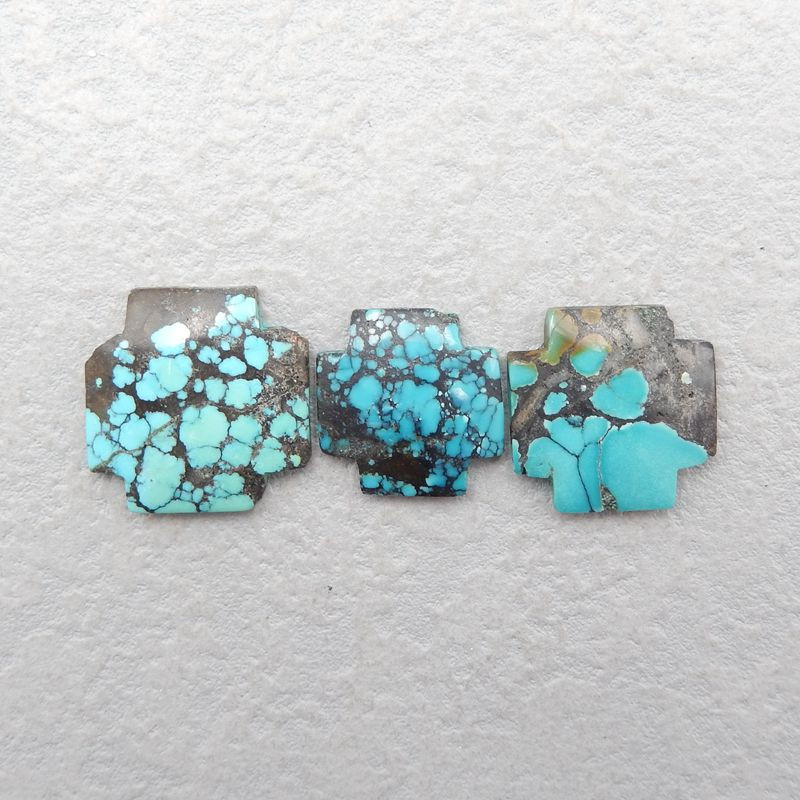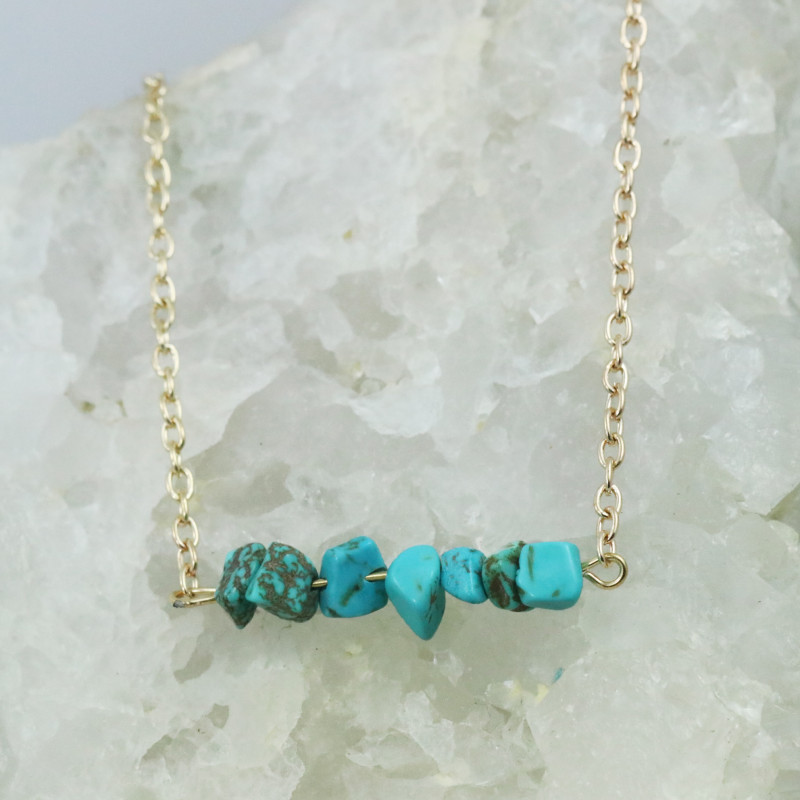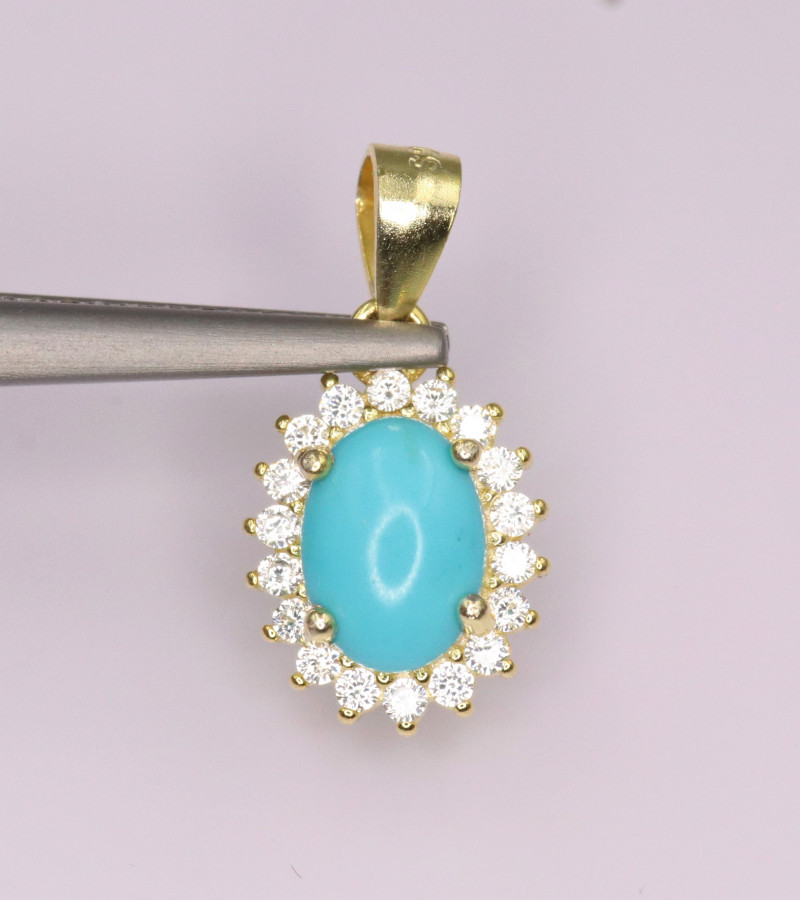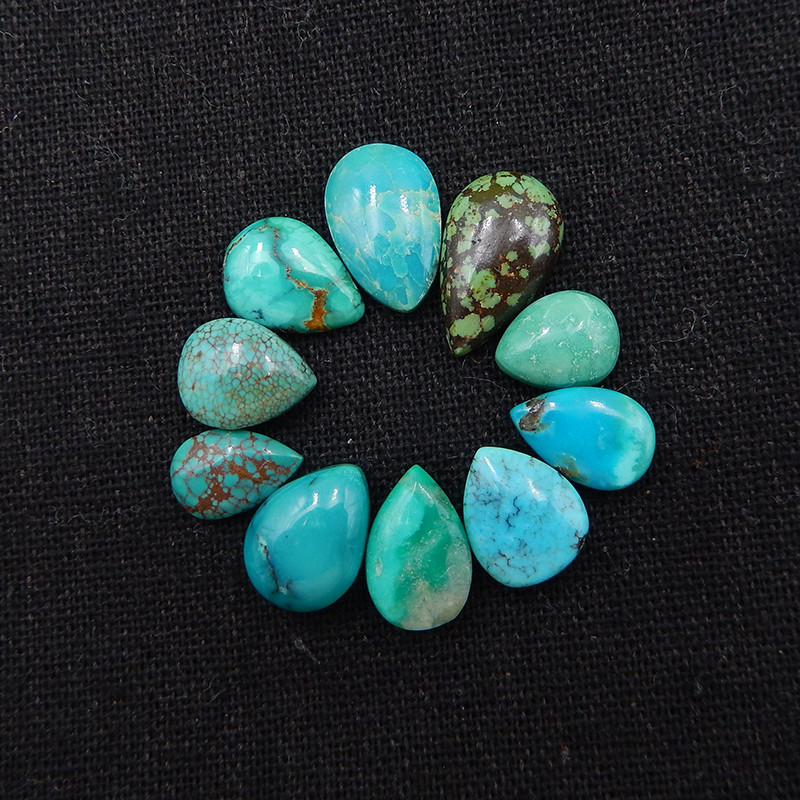
Turquoise Stone: Benefits, Meanings, Properties & Uses
 When it comes to the breathtaking beauty of the sea and the sky, turquoise stones are your best friend! Turquoise is a copper and aluminum-rich phosphate mineral beloved for its versatile properties and uses. Whether you’re seeking healing, protection, or beauty, turquoise can do it all!
When it comes to the breathtaking beauty of the sea and the sky, turquoise stones are your best friend! Turquoise is a copper and aluminum-rich phosphate mineral beloved for its versatile properties and uses. Whether you’re seeking healing, protection, or beauty, turquoise can do it all!
In this holistic guide, we’ll delve into turquoise’s diverse specifications, meanings, healing properties, and so much more. Let’s get started!
About Turquoise
Turquoise stones are blue and green phosphate minerals celebrated for their soothing energy and oceanic beauty. People have coveted turquoise jewelry for thousands of years. Whether you’re a fan of rings, pendants, beads, or necklaces, turquoise is sure to be a stunning pick!
If you or a loved one has a birthday in December, you can happily claim turquoise as your birthstone! Turquoise’s cool blue tones are a fantastic match for any winter babies out there.
Likewise, if your zodiac sign is Sagittarius or Capricorn, turquoise is the perfect stone for you. For the ambitious and enthusiastic Sagittarius, turquoise can help you achieve prosperity. For the strong yet often stubborn Capricorn, turquoise can help you foster more open communication.
Let’s get scientific for a hot second! Turquoise is a hydrated phosphate full of copper and aluminum. That means that if you dunk turquoise in water, it’ll absorb the liquid.
As a porous mineral, turquoise teeters between 5-6 on the Mohs scale of mineral hardness just below quartz. As a comparison to everyday objects, turquoise is softer than a steel nail!
Let’s dive into more about turquoise gemstone composition.

Turquoise Specifications and Characteristics
Color: Turquoise, pale to dark blue, blue-green, yellow
Crystal structure: Triclinic
Luster: Vitreous (crystals), waxy or dull (massive)
Transparency: Transparent to translucent (rare), opaque
Refractive index: 1.590-1.650
Specific gravity: 2.40-2.90
Cleavage: None (massive)
Now that we’ve touched base on its chemical properties, what does turquoise stone symbolize?

Turquoise Stone Meaning
The name turquoise stems from the 17th century through the French word turquois, or “Turkish.” After all, Turkish travelers first introduced medieval Europe to turquoise stones from Persian mines.
Is turquoise a lucky stone? You bet! As a popular symbol of good luck, turquoise can bring you success and fortune. The next time you’re pursuing that promotion at work, carry some turquoise for an extra shot of luck.
Along with good luck, turquoise represents hope and serenity as well. Try decorating your home or office with this sky-blue stone to reap some well-deserved peace and happiness. You can even meditate with your turquoise stone, whether by itself or in a crystal grid.
Finally, turquoise symbolism offers protection against danger, particularly your personal health. According to popular beliefs, if your turquoise stone breaks, consider this a warning of danger! If your gem pales in color, you may fall ill soon. Meanwhile, a total loss of color can indicate the owner’s death — but of course, this is part of the stone’s lore and legend.
Speaking of your health, what is the healing power of turquoise?

Turquoise Healing Properties
Like most gems, turquoise can double as a powerful healing stone. So, what are the benefits of turquoise stones?
Turquoise Physical Healing
Strengthens immune system
Absorbs nutrients
Regenerates damaged tissue
Heals eyes and sore throats
Alleviates body pain
Turquoise Emotional Healing
Combats depression and fatigue
Prevents panic attacks
Promotes inner harmony
Turquoise Spiritual Healing
Improves self-realization
Activates the heart, throat, and third-eye chakras
Stabilizes the lower chakras
What are the chakras, anyway? Chakras are sacred energy centers that flow from the crown of your head to the base of your spine.
The heart chakra is the center of your love, compassion, and empathy. The throat chakra controls your ability to communicate and express yourself. Finally, the third-eye chakra unlocks your intuition and foresight.
When your chakras are blocked, you can suffer physical and spiritual pain. Fortunately, turquoise stones can open these chakras and heal you inside and out.
How else have people revered turquoise’s unique properties throughout history?

Turquoise History
Societies from all over the world have cherished turquoise stones for many millennia. Starting from circa 3000 BCE, Ancient Egyptians began mining turquoise for jewelry and ceremonial use. Ancient Chinese and American civilizations would later do the same.
Remember how turquoise can bring good luck? Well, this belief spans back several centuries across different cultures.
For example, the Aztecs revered turquoise the way other societies revered gold and emerald. The Aztecs used turquoise as sacrificial offerings to their deities. According to Aztec mythology, the god Quetzalcoatl passed down the art of cutting and polishing turquoise.
Because of turquoise’s special status, Aztecan rulers wore turquoise beaded bracelets as protective amulets. After they died, esteemed chiefs were buried with turquoise fragments inserted in their mouths.
Up in North America, the Apache tribes believed that turquoise stones possessed many mystical powers. As such, the Apache decorated themselves with protective turquoise amulets, beads, and pendants. Apache shamans were considered illegitimate if they didn’t own any turquoise.
As we mentioned earlier, ancient Persia (present-day Iran) introduced turquoise to medieval Europe through Turkish travelers. Turquoise experienced a surge in popularity during the Victorian era. Jewelers liked to set the stone in gold, a practice that modern-day jewelers tend to follow as well.

Turquoise Stone Origins
Most turquoise is found in nodule deposits and host rocks, either as veins or shallow crusts. When you look at a turquoise stone, you’ll find colorful, vein-like strands running across its surface.
Known as “matrixes,” these veins or patches are remnants of the host rock that turquoise is formed within. Some common host rocks include chalcedony, opal, and white kaolinite. Matrixes can influence a stone’s color and durability.
Turquoise is a secondary mineral. Unlike primary minerals, which form during crystallization, secondary minerals result during later weathering processes.
Other minerals that often grow together with turquoise are malachite and chrysocolla. Like turquoise, both of these gemstones carry shades of bluish-green and plenty of copper.
Where can we find turquoise around the world?
Turquoise Sources
The U.S. and China are the top global suppliers of turquoise. In China, turquoise mines exist in the Hubei and Shaanxi provinces. Chinese turquoise gemstones come in pale blue to light green colors and are usually softer than their American counterparts.
Over in the U.S., Nevada, Arizona, Colorado, and New Mexico produce quality turquoise. Nevada mines more turquoise gemstones than all the other states combined!
The most notable U.S. turquoise deposit, however, dwells in Lynch Station, Virginia. Here, you’ll find the world’s only source of transparent and translucent turquoise crystals. If you’re able to secure turquoise from this location, you’ve got an incredibly rare and valuable jewel in your hands!
Across the world, Iranian mines historically supplied a highly prized variety of turquoise called “Persian grade.” Persian-grade turquoise stones are celestial blue with no visible matrixes.
Some Iranian mines still produce Persian-grade gems today. The Sleeping Beauty Mine in Arizona delivers similar kinds of stones as well.
Other turquoise mines around the globe include:
Australia
Chile
Brazil
India
Mexico
Once raw turquoise gems become market-ready, it’s time to go jewelry shopping!

Turquoise Gemstone Properties
When you shop for quality turquoise jewelry, you’ll want to assess these gemstone properties:
Color. Turquoise colors range from turquoise to blue to even sometimes yellow. Turquoise receives its blue shades from copper, green from chromium and vanadium and yellow from iron. If you’re a fan of matrix patterns, consider getting a spiderweb turquoise stone with a lace-patterned black matrix!
Carat Weight. Turquoise gemstones are often sold commercially at around 4-8 carats. Larger jewels work great as ornamental pieces.
Clarity. Most turquoise stones are opaque — they’re matte with colorful spider web-like inclusions called matrixes. Turquoise matrix patterns are breathtakingly beautiful and range from black to gold.
Cut. Gem-quality turquoise gems are typically carved into cabochons, inlay, and carvings. Lower-grade stones are fashioned into beads, whether they’re polished or “nugget-style.”
Finally, you may want to think about turquoise gems that are synthetic or have received treatment.

Treatment and Synthetics
Most turquoise gems undergo some form of treatment before hitting the market. Gemstone treatments are entirely safe and standard procedures that enhance a jewel’s color and clarity. For some turquoise gemstones, that means deepening their pale colors to a dark and rich tone.
Synthetic turquoise does exist, both with or without matrix patterns. Popular synthetic options include glass, plastic, and ceramic. Some natural gemstones, like variscite, often resemble turquoise and can serve as alternatives.
The Pierre Gilson Company created the most well-known synthetic turquoise in 1972. Unlike many other synthetics, these artificial turquoise gems are nearly indistinguishable from their natural counterparts. However, if you compare the two varieties under a microscope, you’ll discover that natural turquoise has a smooth surface while Pierre Gilson turquoise carries an oatmeal-like texture.
As you shop around, keep in mind that many turquoise gemstones might not be turquoise at all! Instead, they may be other minerals or objects that are simply turquoise-colored.
For example, howlite and magnesite are often dyed blue to mimic turquoise — be sure to keep an eye out for these! Always double-check with the seller and read product descriptions carefully.
Speaking of careful, let’s explore how we can best take care of our turquoise jewelry.

Turquoise Care and Maintenance
As a fairly delicate stone, you’ll need to lavish extra love and care onto your turquoise stones!
With that said, be sure to save your turquoise jewelry for occasional use. If you’re thinking of buying a turquoise ring, don’t forget to include protective settings to preserve your jewels. Store your turquoise in a fabric-lined container away from other gemstones to prevent scratches.
Another vital fact to consider is that turquoise absorbs liquids and gases very quickly. That’s why you should keep your jewelry away from any heat and chemicals. You’ll want to avoid any irreversible damage!
When it comes to cleaning turquoise stones, steer clear of soaps, detergents, and mechanical cleaners. Again, turquoise is highly porous and will soak in these harmful chemicals.
Instead, wipe down your gems with a damp cloth and carefully wipe them dry. You’ll want to do this each time you wear your jewelry to keep it fresh and clean.
We’ve now covered what kind of turquoise jewelry to shop for and how to care for it. But just how much does turquoise cost anyway?

Turquoise Prices and Value
As a popular and prized gemstone, it’s no surprise that turquoise can be very expensive. Premium jewels can cost up to $500 per carat!
However, turquoise stone prices offer a lot of variety and flexibility — a win for anyone with a budget! In fact, turquoise jewelry can cost as little as five cents per carat. If you’re looking for a more mid-range price, you can expect to find quality turquoise at $30-40 per carat.
What accounts for this diverse price range? Color evenness and saturation play a significant role in turquoise valuation.
In general, darker-colored stones are more valuable. Turquoise gems that are green or greenish-blue are seen as less desirable and therefore less expensive. (Of course, if green is your favorite color, then feel free to rock it!)
What is the most valuable turquoise? Many consider the infamous Persian-grade turquoise that we mentioned earlier to be the most valuable variety of turquoise. With its deep, rich color and lack of inclusions, Persian-grade turquoise is definitely a rare catch!
Ultimately, no matter your style or budget, you’ll easily find turquoise jewelry that suits you. That’s just how versatile turquoise is!

Treasure Turquoise Today!
We’ve shared everything there is to know about turquoise stones — From the ancient Egyptians to the Aztecs to modern-day society, history has shown how powerful and enchanting turquoise is. Are you ready to buy turquoise online?
Within this serene blue stone lies an entire world of magnetic properties and uses. Whether you need a protective amulet, healing crystal, beautiful birthstone, or gorgeous jewelry, turquoise is the stone for you. All it takes is a bit of turquoise to brighten your days!
In the market to buy turquoise? Shop for turquoise stones from Gem Rock Auctions today!
Search the Gemstone Encyclopedia
Related Auctions
Related Articles
Originally the Birthstones or gemstones were associated with a zodiac sign or the month of a individuals birth. Find out what your stone is and view the stones we have for sale
8th Feb 2021
There are dozens of quartz and chalcedony gems with various colors and patterns. Learn all about quartz properties and every type of quartz, from amethyst and agate to plasma and phantom quartz!
15th Oct 2020
Hackmanite is a pink to violet sodalite gem known for its unique color-change and luminescence. Learn why hackmanite is special, from its rare qualities to the types of hackmanite jewelry available.
28th Mar 2018
Latest Articles
Shortite is a rare mineral and rarer gemstone, usually found as colorless or yellow wedge-shaped crystals. Learn the value, history, and properties of shortite in this guide!
9th Dec 2024
Senarmontite is an uncommon antimony mineral mostly used industrially but occasionally collected as rare gems or pearly crystals. Find out all of the traits, uses, prices, and history of senarmontite.
27th Nov 2024
Tantalite is a group of red, brown, or black minerals containing the rare and valuable element tantalum. Discover the uses, history, prices, and properties of tantalite gemstones in this guide!
11th Nov 2024
Article Categories
How To's is where you will find helpful articles from gem Rock Auctions on how to cut gemstones, select gemstones and buy gemstones.
9 Articles





